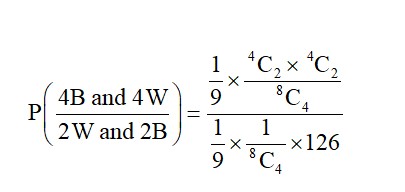The number of solutions of the equation sin⁻¹[x² + 1/3] + cos⁻¹[x² - 2/3] = x², for x ∈ [-1,1] and [x] denotes the greatest integer less than or equal to x, is:
The number of solutions of the equation sin⁻¹[x² + 1/3] + cos⁻¹[x² - 2/3] = x², for x ∈ [-1,1] and [x] denotes the greatest integer less than or equal to x, is:
Option 1 -
2
Option 2 -
0
Option 3 -
Infinite
Option 4 -
4
-
1 Answer
-
Correct Option - 3
Detailed Solution:sin?¹(x² + 1/3) + cos?¹(x² - 2/3) = x²
The domains of sin?¹ and cos?¹ require:-1 ≤ x² + 1/3 ≤ 1 ⇒ -4/3 ≤ x² ≤ 2/3. Since x² ≥ 0, we have 0 ≤ x² ≤ 2/3.
-1 ≤ x² - 2/3 ≤ 1 ⇒ -1/3 ≤ x² ≤ 5/3.
The intersection of these domains is 0 ≤ x² ≤ 2/3.The range of sin?¹ is [-π/2, π/2] and cos?¹ is [0, π].
Let A = sin?¹(x² + 1/3) and B = cos?¹(x² - 2/3).
The equation is A + B = x².
The LHS, A+B, is a sum of angles, while the RHS, x², is in the range [0, 2/3]. This suggests no solution. The p...more
Similar Questions for you
P (2 obtained on even numbered toss) = k (let)
P (2) =
P (
If x = 0, y = 6, 7, 8, 9, 10
If x = 1, y = 7, 8, 9, 10
If x = 2, y = 8, 9, 10
If x = 3, y = 9, 10
If x = 4, y = 10
If x = 5, y = no possible value
Total possible ways = (5 + 4 + 3 + 2 + 1) * 2
= 30
Required probability
P (2W and 2B) = P (2B, 6W) × P (2W and 2B)
+ P (3B, 5W) × P (2W and 2B)
+ P (4B, 4W) × P (2W and 2B)
+ P (5B, 3W) × P (2W and 2B)
+ P (6B, 2W) × P (2W and 2B)
(15 + 30 + 36 + 30 + 15)
Let probability of tail is
⇒ Probability of getting head =
∴ Probability of getting 2 heads and 1 tail
ax2 + bx + c = 0
D = b2 – 4ac
D = 0
b2 – 4ac = 0
b2 = 4ac
(i) AC = 1, b = 2 (1, 2, 1) is one way
(ii) AC = 4, b = 4
(iii) AC = 9, b = 6, a = 3, c = 3 is one way
1 + 3 + 1 = 5 way
Required probability =
Taking an Exam? Selecting a College?
Get authentic answers from experts, students and alumni that you won't find anywhere else
Sign Up on ShikshaOn Shiksha, get access to
- 65k Colleges
- 1.2k Exams
- 679k Reviews
- 1800k Answers


